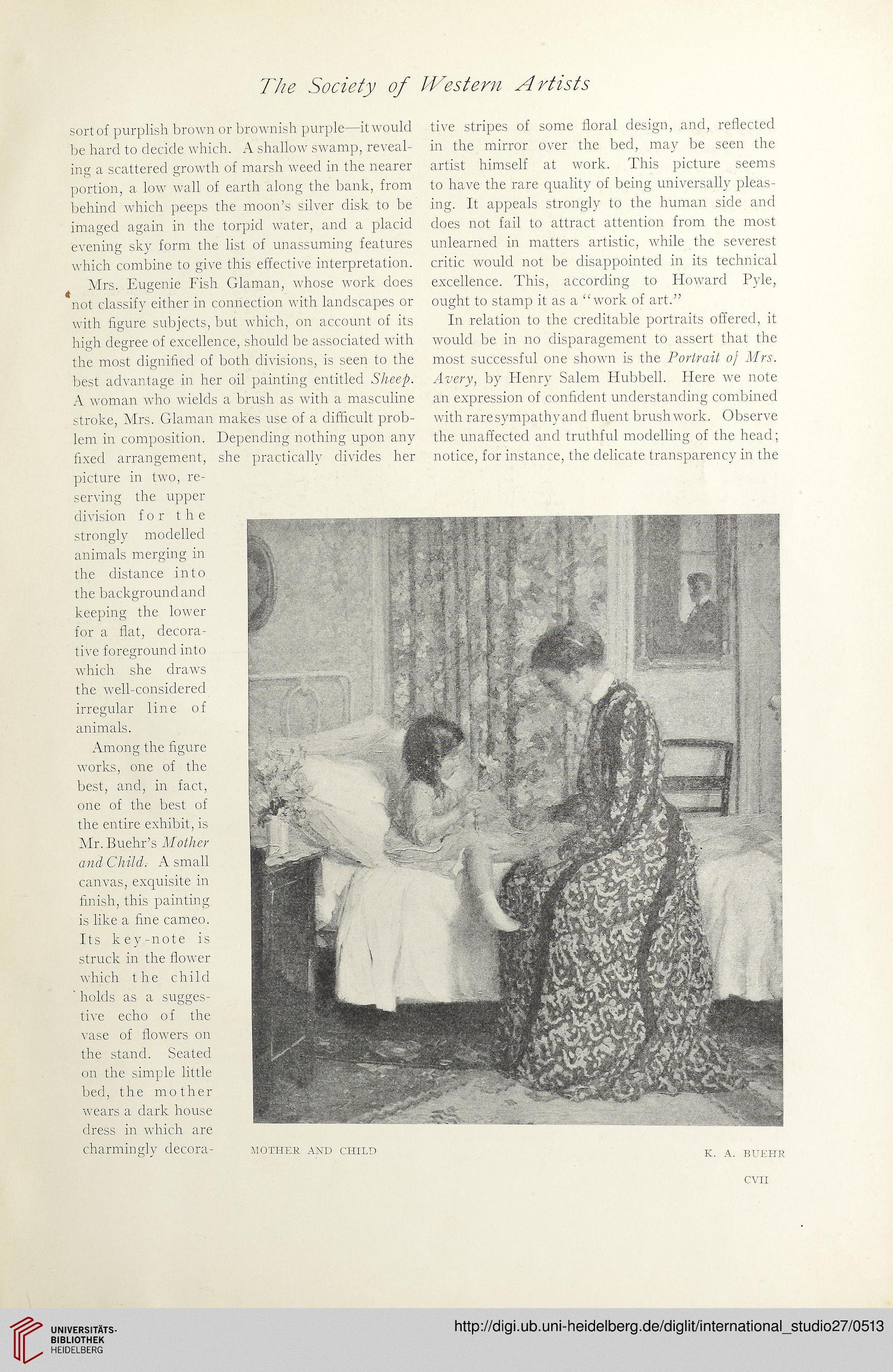The Society of Western Artists
sortof purplish brown or brownish purple—itwould
be hard to decide which. A shallow swamp, reveal-
ing a scattered growth of marsh weed in the nearer
portion, a low wall of earth along the bank, from
behind which peeps the moon’s silver disk to be
iniaged again in the torpid water, and a placid
evening sky form the list of unassuming features
which combine to give this effective interpretation.
* Mrs. Eugenie Fish Glaman, whose work does
not classify either in connection with landscapes or
with figure subjects, but which, on account of its
high degree of excellence, should be associated with
the most dignified of both divisions, is seen to the
best advantage in her oil painting entitled Sheep.
A woman who wields a brush as with a masculine
stroke, Mrs. Glaman makes use of a difficult prob-
lem in composition. Depending nothing upon any
fixed arrangement, she practicallv divides her
picture in two, re-
serving the upper
division for the
strongly modelled
animals merging in
the distance into
the backgroundand
keeping the lower
for a flat, clecora-
tive foreground into
which she draws
the well-considered
irregulär line of
animals.
Among the figure
works, one of the
best, and, in fact,
one of the best of
the entire exhibit, is
Mr. Buehr’s Mother
and Child. A small
canvas, exquisite in
frnish, this painting
is like a fine cameo.
Its key-note is
struck in the flower
which the child
' holds as a sugges-
tive echo of the
vase of flowers on
the stand. Seatecl
on the simple little
bed, the mother
wears a dark house
dress in which are
charmingly decora- mother and child
tive stripes of some floral design, and, reflected
in the mirror over the bed, may be seen the
artist himself at work. This picture seems
to have the rare quality of being universally pleas-
ing. It appeals strongly to the human side and
does not fall to attract attention from the most
unlearned in matters artistic, while the severest
critic would not be disappointed in its technical
excellence. This, according to Howard Pyle,
ought to stamp it as a “work of art.”
In relation to the creditable portraits offered, it
would be in no disparagement to assert that the
most successful one shown is the Portrait o/ Mrs.
Avery, by Henry Salem Hubbell. Here we note
an expression of confident understanding combined
with rare sympathy an cl ment brush work. Observe
the unaffected and truthful modelling of the head;
notice, for instance, the delicate transparency in the
K. A. BÜEHR
CVII
sortof purplish brown or brownish purple—itwould
be hard to decide which. A shallow swamp, reveal-
ing a scattered growth of marsh weed in the nearer
portion, a low wall of earth along the bank, from
behind which peeps the moon’s silver disk to be
iniaged again in the torpid water, and a placid
evening sky form the list of unassuming features
which combine to give this effective interpretation.
* Mrs. Eugenie Fish Glaman, whose work does
not classify either in connection with landscapes or
with figure subjects, but which, on account of its
high degree of excellence, should be associated with
the most dignified of both divisions, is seen to the
best advantage in her oil painting entitled Sheep.
A woman who wields a brush as with a masculine
stroke, Mrs. Glaman makes use of a difficult prob-
lem in composition. Depending nothing upon any
fixed arrangement, she practicallv divides her
picture in two, re-
serving the upper
division for the
strongly modelled
animals merging in
the distance into
the backgroundand
keeping the lower
for a flat, clecora-
tive foreground into
which she draws
the well-considered
irregulär line of
animals.
Among the figure
works, one of the
best, and, in fact,
one of the best of
the entire exhibit, is
Mr. Buehr’s Mother
and Child. A small
canvas, exquisite in
frnish, this painting
is like a fine cameo.
Its key-note is
struck in the flower
which the child
' holds as a sugges-
tive echo of the
vase of flowers on
the stand. Seatecl
on the simple little
bed, the mother
wears a dark house
dress in which are
charmingly decora- mother and child
tive stripes of some floral design, and, reflected
in the mirror over the bed, may be seen the
artist himself at work. This picture seems
to have the rare quality of being universally pleas-
ing. It appeals strongly to the human side and
does not fall to attract attention from the most
unlearned in matters artistic, while the severest
critic would not be disappointed in its technical
excellence. This, according to Howard Pyle,
ought to stamp it as a “work of art.”
In relation to the creditable portraits offered, it
would be in no disparagement to assert that the
most successful one shown is the Portrait o/ Mrs.
Avery, by Henry Salem Hubbell. Here we note
an expression of confident understanding combined
with rare sympathy an cl ment brush work. Observe
the unaffected and truthful modelling of the head;
notice, for instance, the delicate transparency in the
K. A. BÜEHR
CVII




